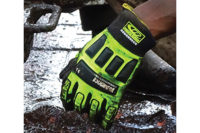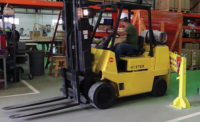
You probably know what it says in 29 CFR 1910.1200 about having to keep copies of MSDSs for all of those chemicals used at your facility. And you probably also know all the familiar reasons why it seems to be such a chore:
- Not enough time to keep them current. "I'm wearing too many 'hats' within my organization."
- Staff personnel purchases chemicals without going through the proper process.
- With the huge number of materials used on site, it's difficult to track everything.
Hazard Communication violations continue to lead the number of OSHA citations issued (7,421 from October 1999 through September 2000, according to OSHA's Web site). Your goal is to have 100 percent of the MSDSs, 100 percent of the time, and to allow instant access by any employee without supervisory assistance so that your company doesn't become a statistic.
What type of system will be right for you and your employees? And how can you make the task of MSDS compliance easier?
There is no universal solution. Every company is different, and each one must be able to justify the cost involved in installing the system that will meet its needs.
Four primary methods
The "Elegant" Solution - You can pay a vendor company to keep all of your MSDSs on their computers. Part of this service is to scan your MSDSs into their system and index them. In addition, they can allow you access to their database of MSDSs. Anyone in the company can log in and look up and print an MSDS using the Internet and a Web browser.The "Less Elegant" Solution - You buy an MSDS software package that helps you file and index all MSDSs, or you buy a scanner, scan all of your MSDSs into a file for each document, index those documents, add keywords and put it all into a database.
The "Hybrid" Solution - This is a combination of Web-access, local/network server that allows an employee to enter the name of a chemical, the product name or the part number, and the system will retrieve an MSDS from whatever source is fastest. This is usually handled by a specialty software package.
The "Everyman" Solution - Make photocopies of the MSDS and place them in notebooks or file cabinets in various departments that use the chemicals.
Pros and cons
Before you jump headfirst into any of these solutions, realize that each one has pros and cons that can affect the implementation in your company.
- Computer-based systems (Internet or local) require a workforce that is comfortable using computers and understands how to access information on the Internet/network drive/CD-ROM. Most information on the Internet is in English, so if your employees are not fluent in English, that information will not help them in an emergency. You may not be able to access any computer-based system in the event of a power failure. Copies printed from either the Internet or a computer-based system are as good as the originals.
- Scanned images may go into the computer either as a text document or as an image, depending on the software package used. The FIND command will not work on graphics files or embedded images in Adobe Acrobat pdf files. However, scanned images can be saved on CD-ROMs and distributed to all departments and/or customers. This ensures that you will not lose any MSDSs, but, again, CD-ROMs cannot be read if there is a power failure.
- Paper files are usually the easiest type of system to set up and use. Employees must understand the filing system, including whether the MSDSs are filed by chemical name, manufacturer's name or code number, and whether there is an index and cross-reference. The biggest problem is making sure employees return the MSDS to the correct location in the paper file after they've used it, or remembering to return it at all.
With paper files, all departments must have the most current version of an MSDS - easier said than done. For example, the manufacturing department might have an MSDS for toluene from 1984 while the processing department's copy is from 2000, and the finishing department might have both copies! Additionally, multiple copying tends to degrade the image until some information may be unreadable.
There's also the issue of availability. OSHA requires that employees are able to get an MSDS at any time and without a supervisor's intervention. Paper systems usually allow this. With an Internet system, copies can be obtained at the click of a button or from any computer - again, only if the employees have access to one.
Real-world examples
Different systems may work well for different companies. I know of a large retail food distribution company that uses a combination of an Internet system and paper. Each location has a safety coordinator responsible for going to the company Web site and downloading a copy of the MSDS. That copy is then filed in various MSDS notebooks at the distribution facility. The Web site is, in essence, the master file.
I also know of a printing company that uses a combination system, as well. The person in charge of health and safety compliance scans the MSDS into a database, and the information is saved on the network. Each facility can download a copy from the network. The paper copy allows access anytime, and the scanned image is also the master file.
Tough questions
To help figure out what type of system is best for your company, ask the following questions:
- Do ALL of my employees - from the president to the janitor - feel comfortable using a computer? If we use a computer-based system, where is the data backed up? How secure is the data?
- Can my employees comprehend the MSDS training and retain all the information? Will they remember how to use the indexing system three months later if they have a spill?
- Do we have or can we obtain the money, equipment and/or administrative support necessary to maintain the system? Can we afford the fines if we don't have this system?
- Regardless of the system used, is the data in the system current?
- Will the MSDSs be complete, or will they say "proprietary" to each question? Is your company large enough to get your suppliers to provide all of the ingredients in a product?
- If your company is multinational or you have a multinational workforce, how many languages will you need for your MSDS?
Only as you address these tough questions will you be able to determine the MSDS system that is best suited for your company's needs.

